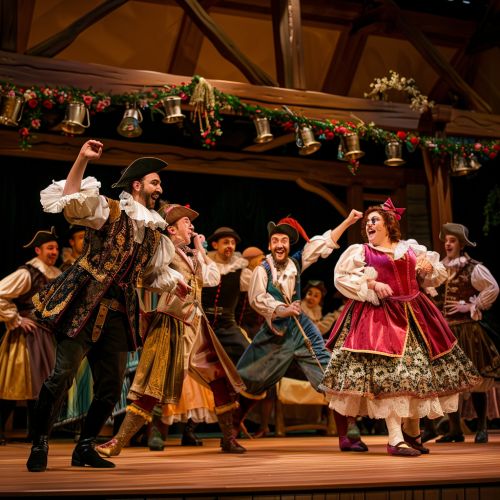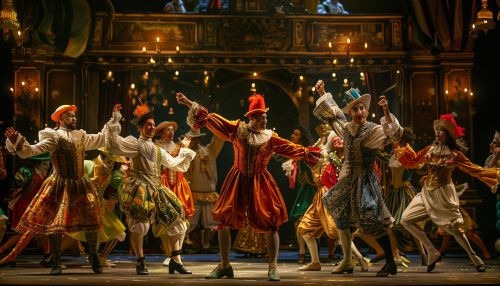Commedia dell'arte
Origins and Development
Commedia dell'arte, which translates to "comedy of the profession," was an early form of professional theatre, originating from Italy, that was popular in Europe from the 16th through the 18th centuries. It was characterized by masked "types" and the advent of the actress and improvised performances based on sketches or scenarios.
The earliest known company formed in Padua in 1545, and by the turn of the 17th century, troupes such as the Gelosi, Confidenti, and Fedeli were performing in France. The characters, or "masks," which were essentially fixed social types, were a major driving force of the comedy in Commedia dell'arte. The characters were drawn from the reality of the time, and included servants, old men, lovers, and captains, each of which had a distinctive costume and mask.


Characters
The characters of Commedia dell'arte included both stock characters, which were fixed social types, and character roles, which were unique for each performance. The stock characters were drawn from the reality of the time and included servants, old men, lovers, and captains. Each character had a distinctive costume and mask, and each also had a specific function within the comedy.
Servants or Zanni
The Zanni characters were usually servants, peasants, or workers. They were characterized by their witty remarks, physical agility, and cleverness. They were often the ones who drove the action in the plays. The most famous Zanni characters were Arlecchino, Brighella, and Pulcinella.
Old Men or Vecchi
The Vecchi were often portrayed as wealthy and miserly, with a penchant for scheming. They were often the fathers of the Innamorati and were characterized by their long noses, symbolizing their deceitful nature.
Lovers or Innamorati
The Innamorati were often the children of the Vecchi and were always in love, often with each other. They were characterized by their youth, beauty, and elegance.
Captains or Capitani
The Capitani were often portrayed as braggarts and cowards, with a penchant for boasting about their military exploits, often exaggerated or entirely false. They were characterized by their large, feathered hats and swords.
Performance Style
Commedia dell'arte was characterized by its improvisational style. The actors were given a scenario, a rough outline of the plot, and would then improvise the dialogue. This required a high degree of skill and a strong sense of comic timing. The performances were often accompanied by music and dance, and were performed on temporary stages, often outdoors.
Influence and Legacy
Commedia dell'arte had a significant influence on European theatre. It introduced the concept of the actress, professionalized the theatre, and shifted the focus from text to performance. Its influence can be seen in the works of Shakespeare, Molière, and Lope de Vega.
The stock characters of Commedia dell'arte, with their masks and costumes, have become iconic figures in the world of theatre, and their influence can be seen in modern forms of comedy such as sitcoms and animated cartoons.
